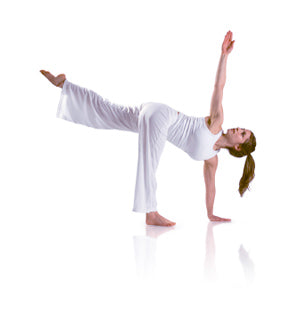How to Do Revolved Downward-Facing Dog Pose in Yoga
 Revolved Downward-Facing Dog is a variation of the popular inverted pose, Downward Dog (Adho Mukha Svanasana). It adds a deeper stretch to the hamstrings while enhancing detoxification, balance, and full-body coordination.
Revolved Downward-Facing Dog is a variation of the popular inverted pose, Downward Dog (Adho Mukha Svanasana). It adds a deeper stretch to the hamstrings while enhancing detoxification, balance, and full-body coordination.
The Sanskrit name for this pose, "Parivrtta Adho Mukha Svanasana" (PAHR-ee-VREE-tah Ah-doh MOO-kuh shvan-AHS-uh-nuh), comes from five words:
- “Parivrtta” — meaning “revolved”
- "Adho" — meaning "downward"
- "Mukha" — meaning "face"
- "Svana" — meaning "dog"
- "Asana" — meaning "pose"
It also goes by various other English names, including “Revolving Downward Dog,” “Down Dog Twist,” “Twisting Down Dog,” and others. No matter what your teacher calls it, you'll gain all of this pose's full-body benefits!
Benefits of Revolved Downward-Facing Dog Pose
Revolved Downward-Facing Dog has all of the same benefits as Downward Dog, including:
- Full-body stretching
- Strength-building
- Increased blood flow
- An energized and rejuvenated nervous system
- Relief from stress, headaches, fatigue, poor digestion, and back pain
A yogi's task in any pose is to notice the holistic relationship among all the parts of the body.
This variation has the added bonus of deeply stretching your hamstrings, shoulders, torso, and ribs. It also improves your body's overall balance! Twisting your torso massages and tones your internal organs, which helps to remove toxins and waste products. Cleansing these organs also improves metabolism, digestion, and overall well-being.
Cautions
Do not practice Revolved Downward-Facing Dog if you have severe carpal tunnel syndrome or are in late-term pregnancy. It should also be avoided by those with injuries to the back, arms, or shoulders; and by those with high blood pressure, eye or inner ear infections. Always work within your own range of limits and abilities. If you have any medical concerns, talk with your doctor before practicing yoga.
Instructions
- Begin on your hands and knees. Align your wrists directly under your shoulders and your knees directly under your hips. The fold of your wrists should be parallel with the top edge of your mat. Point your middle fingers directly to the top edge of your mat.
- Stretch your elbows and relax your upper back.
- Spread your fingers wide and press firmly through your palms and knuckles. Distribute your weight evenly across both hands.
- Exhale as you tuck your toes and lift your knees off the floor. Reach your pelvis up toward the ceiling. Then draw your sit bones toward the wall behind you. Gently begin to straighten your legs, but do not lock your knees. Bring your body into the shape of an “A.” Imagine your hips and thighs being pulled backwards from the top of your thighs. Do not walk your feet closer to your hands — keep the extension through your whole body. This is Downward-Facing Dog.
- On an inhalation, lift your left hand and reach it beneath your torso and around to your right thigh. Allow your waist and torso to twist open to the right. Work toward placing your left hand on the ground to the outside of your right foot. If that is not possible yet, rest your hand on the outside of your right leg's shin or upper thigh.
- Turn your head to look underneath your right arm. Keep your gaze soft. If you have no neck pain, gaze up at the ceiling.
- Hold for 5-10 breaths. To release, inhale as you un-twist and return your left hand to the mat. Come back into Downward-Facing Dog. Repeat the pose on the other side for the same amount of time, and then return to Downward-Facing Dog again.
Modifications & Variations
Revolved Downward-Facing Dog is a challenging variation that will add a twist to your regular practice. Try these simple changes to find a version of the pose that works best for you:
- To add increased circulation and warmth throughout your body, try a bent-knee variation. Come into the full pose with your left hand pressing into the floor, placed to the outside your right foot. Then bend your right knee while keeping your left leg straight. Hold for three breaths, and then change sides. Repeat this sequence five times.
- For a greater challenge, try a lifted-leg variation. Come into the full pose with your left hand pressing into the floor, placed to the outside your right foot. Then, lift the leg that is on the same side as your grounded hand. Hold it as high as possible, reaching through the heel. Hold for up to 10 breaths. Return to Downward-Facing Dog, and then repeat on the other side.
Tips
Revolved Downward Dog will stretch and strengthen the whole body when done correctly. Keep the following information in mind when practicing this pose:
- Since Downward-Facing Dog is the foundation for Revolved Downward Dog, it's important to get the alignment correct first in Downward-Facing Dog. Thoroughly review the information in the iSport guide, How to Do Downward-Facing Dog Pose in Yoga, before trying this variation!
- If you are very flexible, do not let your rib cage sink too deeply toward the floor. Draw your lower ribs in and maintain a long, flat back.
- Remember, your heels do not need to touch the ground. Do not worry about it. Avoid walking your feet closer to your hands for this purpose. Maintain the length of your spine and the lift of your pelvis.
Twist Your Dog
Practicing Revolved Downward-Facing Dog will add warmth, suppleness, and flow to your practice. You can use it as a variation of Downward-Facing Dog between poses while practicing Sun Salutations (Surya Namaskara) or vinyasas, or as a full-body stretch on its own. Try a few rounds of this revolved variation throughout your day to energize your body and calm your mind!

